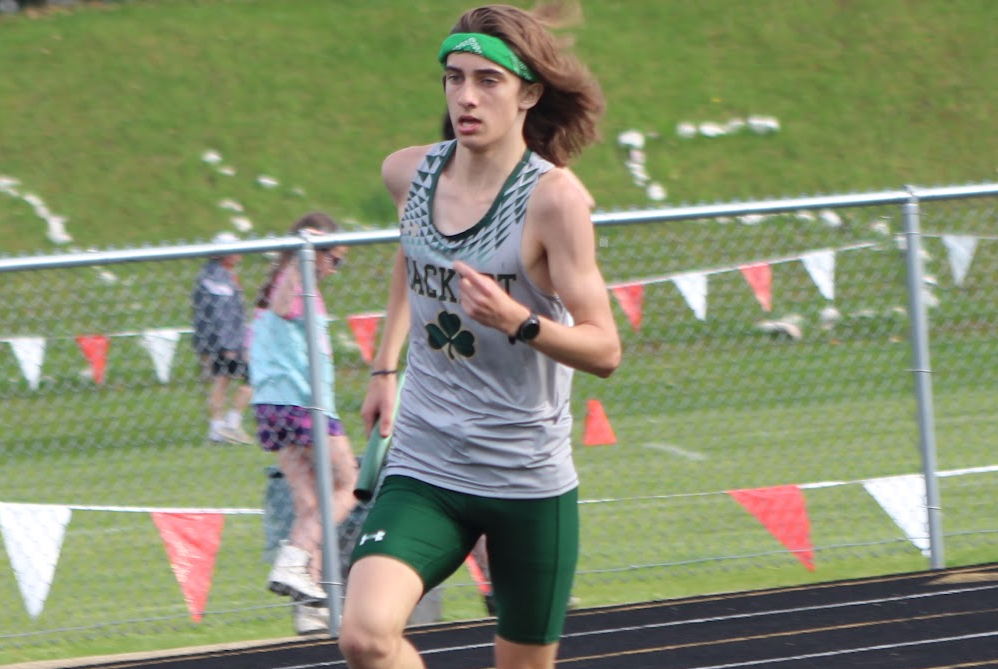
Hackett on Track to Roll Again with Distance Ace Among Those Leading Charge
By
Pam Shebest
Special for MHSAA.com
March 12, 2024
KALAMAZOO — After breaking one track record as a freshman, Marek Butkiewicz already has his eyes on two more.
 Not bad for a runner who did not even plan to run track during his years at Hackett Catholic Prep, a surprise to co-coach Shelly Germinder.
Not bad for a runner who did not even plan to run track during his years at Hackett Catholic Prep, a surprise to co-coach Shelly Germinder.
“I had heard plenty about him from some of the ultras (marathons) and different other races he had done,” Germinder said. "His commitment to the sport came through before we ever laid eyes on who he was. We knew he was going to be an asset to us.”
The current sophomore was not so sure.
“At the end of cross country (freshman year), I didn’t even think I wanted to do track,” Butkiewicz said. “Then I did it and it was ‘This is kind of fun.’
“I was good at it. I honestly didn’t have any desire going into (track season), and then I ran a couple fast times and I thought, ‘I can actually do this.’”
Butkiewicz said his freshman cross country season in 2022 was the first time he really took running seriously, and his interest was boosted when he ran a 17:31 at the Kalamazoo Christian Invitational.
“I was super happy to get the freshman record there,” he said.
This past season, Butkiewicz shattered Hackett’s sophomore cross country record, running a personal best 16:12.2 at the MHSAA Lower Peninsula Division 4 Final, demolishing the record set by Bryan Martin (16:56) in 2000.
That record also has special meaning to Germinder. Martin is her brother.
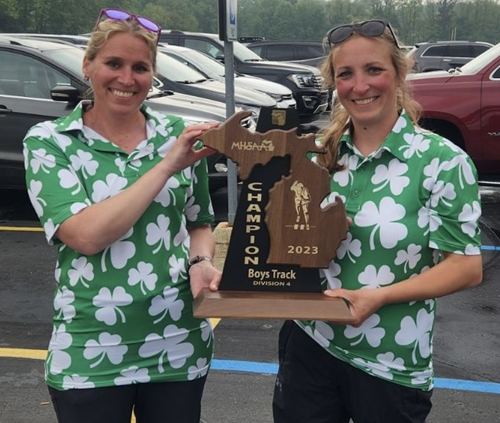 The Irish finished in third place at the Final last fall, one point behind Holland Calvary Christian.
The Irish finished in third place at the Final last fall, one point behind Holland Calvary Christian.
With the start of the spring sports season this week, the Hackett boys are hoping to make it three Finals track & field titles in a row and five over six years.
Last year’s boys team made it a sweep, winning the Southwestern Athletic Conference, Regionals, MHSAA Finals and Michigan Interscholastic Track Coaches Association (MITCA) Team State Finals.
The boys and girls teams also earned MITCA Division 4 academic awards, the girls with a cumulative 3.986 GPA and the boys with a 3.909 GPA.
This year’s team has grown from a combined 54 athletes last year to 64 with 38 boys and 26 girls.
“I think the students as a whole are seeing the successes of the team, but I also think it’s some of the flexibility we have in our sport,” Germinder said. “We know there are kids who want a dual sport and want to be involved in other things, and we want that for them, too.
“In a small school, we can’t be successful if we don’t have kids involved in multiple sports because there just aren’t enough bodies.”
Co-coach Charissa Dean said this year’s boys team will have a different look.
“We lost Liam (Mann), who was a really strong sprinter, and he left some big shoes to fill,” she said. “We have a nice nest egg of freshmen and sophomores.
“We had a junior (Gabe Oeurn) last year who is coming into his own, if you look at his track record from freshman to sophomore to junior. Last year, we had Sam Finley who was a freshman, and a sophomore (Jude Coffman) who was first time out.”
Lofty goals
Butkiewicz’s goal is to break his own school 3,200-meter record plus the 1,600-meter record, currently held by Jose Garza (4:27.4 set in 1976).
He’s pursuing a 9.25 in the 3,200 and 4.20 in the 1,600, while his long-term goal is breaking four minutes, hopefully running at a Division I university.
“His dedication, his commitment,” Germinder said. “You can’t teach that. That’s something he does on his own that comes from within. Snow, rain, whatever it is, he’s out there running, no matter what.”
The sophomore said he had no clue about records when he was a freshman, but after turning in a 10:37 in his first 3,200, then 10:05 followed by a 10 flat, he realized a record was in reach.
Butkiewicz credits his dedication for his success.
“I put in hundreds of miles a month, thousands a year, just into grinding and working toward goals,” he said. “I’ll shoot for 40-45 (miles) in-season. Offseason, when I’m building my aerobic base, I want 50 and upwards.”
As a freshman, he found a running buddy in then-junior Gavin Sehy.
“He was the fastest for the past two years and I was a little ahead of him, so we just stuck with each other and trained together,” Butkiewicz said. “Over the winter we started doing a couple miles together.”
 Sehy, who is headed to Southwestern Michigan College in the fall, is shooting to break the school’s 800 record plus the 3,200 running with Nick Doerr, Alex Dumont and Butkiewicz.
Sehy, who is headed to Southwestern Michigan College in the fall, is shooting to break the school’s 800 record plus the 3,200 running with Nick Doerr, Alex Dumont and Butkiewicz.
Sehy was also a running buddy in cross country, finishing second on the team at 16:21.
“(Sehy) always had the potential, but it wasn’t until Marek came along that he started doing that training in the summer,” Dean said. “It has made a massive difference.”
Sehy and Butkiewicz competed in two ultramarathons (more than 26.2 miles) over the summer.
“I had never ran a marathon before, but somehow Marek convinced me to run 38 miles at Kettle Moraine State Forest (Wisconsin),” Sehy said. “And I did. Later in the summer, I ran 50 in Holly, Michigan.”
In the Wisconsin ultra, Butkiewicz was trying to finish the 100-mile run with Sehy pacing him for about 40 miles.
“I ended dropping at mile 75 because of some hip issues but he kept going and finished it,” Butkiewicz said. “The second one in Holly, I was doing 100 miles and he was doing 50, so we pretty much ran together for the first 50.”
Sehy said the two share the same mentality, which makes it easy to have a training buddy.
“We both really want it so bad, and we’re not afraid to do crazy things to get it,” he said. “Last year, during track, we needed to get some more miles in but just ran out of time during the week, so Sunday night we were out running 18 miles until after the sun went down out in the forest.”
Germinder said Sehy has noted he needs to have another runner to really push him.
“That’s one of the really beautiful things about the relationship they have,” she said. “It’s a healthy competition between them, but they want what’s best for each other, too.”
Butkiewicz lives near a land preserve where the two do much of their training, no matter what the weather, and they make it fun, jumping icy puddles and eating berries along the way.
“The coldest day of the year we ran with no shirts just because we could,” Sehy laughed.
When Sehy isn’t available to train, “I’ve been training a lot with Sean Siems; he’s a sophomore, a huge rising talent,” Butkiewicz said.
New year, new leaders
This year’s team will have a different look.
“We lost Liam and Bryce Brown and Nathan Buchmann (discus and only individual Finals champ),” Sehy said. “It’s tough to lose your best guys, but I think we have so much depth on this team, I think we’ll be all right.”
Just two weeks into the young season, Hackett will be on spring break, so many of the athletes pushed the coaches to schedule a meet before then.
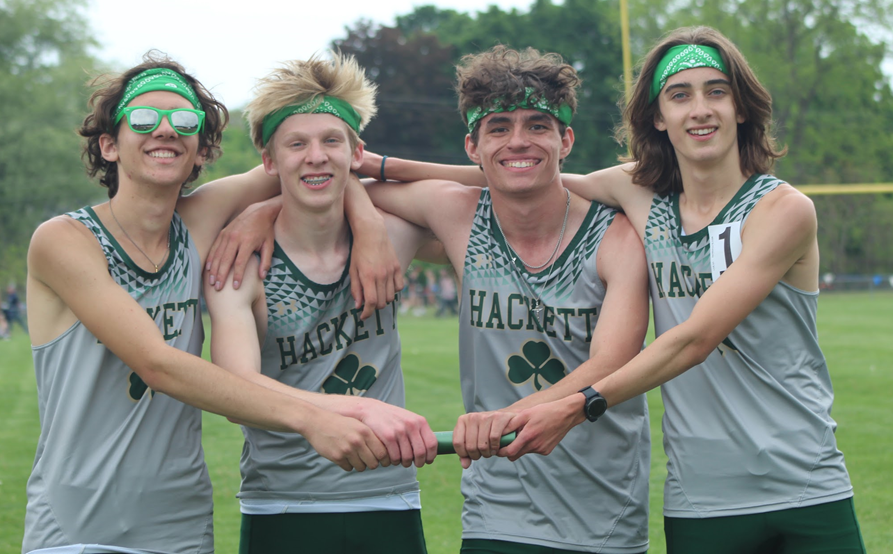 They found one in the Onsted Early Bird Meet on March 20.
They found one in the Onsted Early Bird Meet on March 20.
“They want to see where they are going into spring break to know, is there extra work we need to do during spring break,” Germinder said. “Having a competition will tell them where they’re at.
“If you do nothing (over spring break), then you’re starting all over again. I think a lot of our athletes recognize that and know they have to work a little more.”
Besides Butkiewicz and Sehy, leaders on the team include pole vaulters/sprinters Jack Prom and Lauren Wild.
“Keegan Gallagher is our biggest cheerleader and keeps the team in good spirits,” Germinder added. “He brings something that isn’t just on the track.”
With such large numbers, “If they’re not competing, we like to take them with us on the bus anyway,” Dean said. “They can help support their teammates, they can run a stopwatch, they can take video of the relay handoffs so we can go back and look at it later.”
In spite of the success on the track or in the field, Germinder said she is most proud of the athletes as people.
“With that leadership comes responsibility of good sportsmanship, how they’re interacting with other teams on the line,” she said. “I love watching our boys praying together with other teams before they’re getting ready to run. Or shaking hands before or after, especially sprinting events. It says a lot about who we are.”
 Pam Shebest served as a sportswriter at the Kalamazoo Gazette from 1985-2009 after 11 years part-time with the Gazette while teaching French and English at White Pigeon High School. She can be reached at [email protected] with story ideas for Calhoun, Kalamazoo and Van Buren counties.
Pam Shebest served as a sportswriter at the Kalamazoo Gazette from 1985-2009 after 11 years part-time with the Gazette while teaching French and English at White Pigeon High School. She can be reached at [email protected] with story ideas for Calhoun, Kalamazoo and Van Buren counties.
PHOTOS (Top) Kalamazoo Hackett Catholic Prep’s Marek Butkiewicz rounds a curve during a race last season. (2) Butkiewicz shows the school record board, including his 3,200 entry earned last season. (3) Hackett track coaches Charissa Dean, left, and Shelly Germinder hold up last season’s MHSAA Finals championship trophy. (4) The Hackett 3,200 relay, from left: Gavin Sehy, Alex Dumont, Nick Doerr and Butkiewicz. (Action, coaches and relay photos courtesy of the Kalamazoo Hackett Catholic Prep boys track & field program; record board photo by Pam Shebest.)
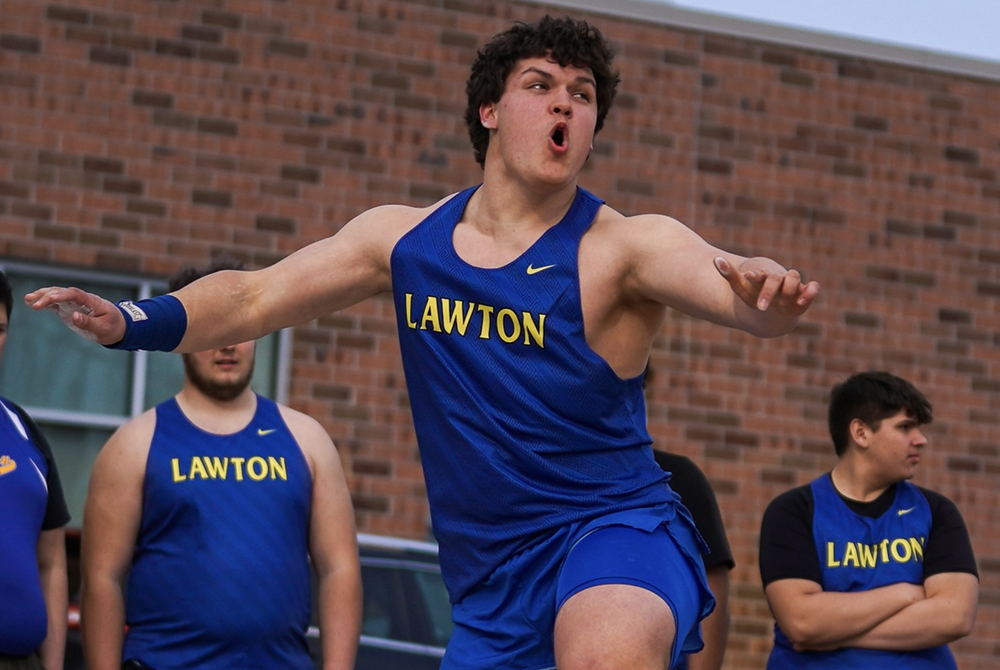
Performance of the Week: Lawton's Mason Mayne
April 25, 2024
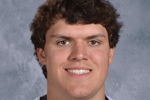 Mason Mayne ♦ Lawton
Mason Mayne ♦ Lawton
Junior ♦ Track & Field
The 6-foot-3, 275-pound two-way lineman is a sizable presence on the football field building toward a possible a big-time future in that sport – and he also dominates in the throws pit during track & field season. He’s undefeated in the shot put and discus this spring and won both at last Friday’s Comstock Invitational, tossing the shot 54 feet, 11 inches, and the discus 171-9.
Mayne finished second in shot put and third in discus at the Lower Peninsula Division 3 Finals last spring, and his top throws this season – 60-3 in shot and 175-4 in discus – are the farthest in the state, regardless of division. He also carries a grade-point average above 4.00 and has received several Division I football scholarship offers including opportunities to play for multiple Ivy League schools and U.S military academies.
@mhsaasports 🥏POW: Mason Mayne #trackandfield #lawton #letsgo #throw #part1 #highschoolsports #tiktalk #interview #performanceoftheweek #mistudentaid #fyp #MHSAA ♬ original sound - MHSAA
@mhsaasports 🥏POW: Mason Mayne #tiktalk #questiontime #part2 #sourgummyworms #nighttime #food #phone #cheese #performanceoftheweek #mistudentaid #fyp #MHSAA ♬ original sound - MHSAA
Follow the MHSAA on TikTok.
MHSAA.com's "Performance of the Week" features are powered by MI Student Aid, a division within the Department of Lifelong Education, Advancement, and Potential (MiLEAP). MI Student Aid encourages students to pursue postsecondary education by providing access to student financial resources and information. MI Student Aid administers the state’s 529 college savings programs (MET/MESP), as well as scholarship and grant programs that help make college Accessible, Affordable and Attainable for you. Connect with MI Student Aid at www.michigan.gov/mistudentaid and find more information on Facebook and Twitter @mistudentaid.
Past 2023-24 Honorees
April 18: Alli Wright, Jenison softball - Report
April 11: Chloe Wishart, Trenton soccer - Report
March 28: Jenna Maki, Ishpeming basketball - Report
March 22: Jaremiah Palmer, Niles Brandywine basketball - Report
March 15: Leah Hodge, North Farmington gymnastics - Report
March 8: Darius Marines, Detroit Catholic Central wrestling - Report
March 1: Rylee Smith, Zeeland West bowling - Report
Feb. 22: Caleb Lewandowski, Traverse City West skiing - Report
Feb. 15: Jadin Mix, Onaway basketball - Report
Feb. 8: Onalee Wallis, Cadillac skiing - Report
Feb. 1: Abbey DeGraw, Rochester Hills Stoney Creek competitive cheer - Report
Jan. 25: Ewan Todd, Riverview swimming - Report
Jan. 18: Ashley Weller, Jackson Northwest basketball - Report
Jan. 11: Michael Baldwin, Saginaw Arthur Hill wrestling - Report
Dec. 15: Jena Fijolek, Fenton bowling - Report
Dec. 8: Sophia Wagner, Escanaba gymnastics - Report
Dec. 1: Isaiah Marshall, Southfield Arts & Technology football - Report
Nov. 24: Sarah Bradley, Clarkston Everest Collegiate volleyball - Report
Nov. 17: Kalieb Osborne, Waterford Mott football - Report
Nov. 10: Tekalegn Vlasma, Muskegon Western Michigan Christian soccer - Report
Nov. 3: Colton Kinnie, Birmingham Seaholm football - Report
Oct. 27: Lauren Timpf, Macomb Lutheran North golf - Report
Oct. 20: Alena Li, Okemos golf - Report
Oct. 13: Seth Norder, Grand Haven cross country - Report
Oct. 5: Paige Anderson, Muskegon Reeths-Puffer golf - Report
Sept. 29: MacKenzie Bisballe, Lake City volleyball - Report
Sept. 22: Jhace Massey, Gladwin football - Report
Sept. 15: Kaylee Draper, Sturgis swimming - Report
Sept. 8: Owen Jackson, Traverse City St. Francis tennis - Report
Sept. 1: Rachel Forsyth, Ann Arbor Pioneer cross country - Report
(Photos by Chris McComis.)

